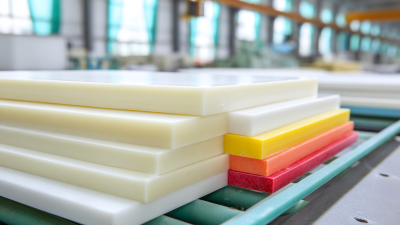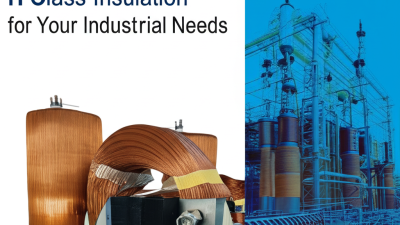The Importance of Transformer Insulation Sheets in Modern Electrical Engineering
Table of Contents
- Understanding Transformer Insulation Sheets and Their Functionality
- Key Materials Used in Transformer Insulation Sheets
- Installation Techniques for Optimal Transformer Insulation
- Maintenance Best Practices for Transformer Insulation Sheets
- Common Issues and Solutions for Transformer Insulation Efficiency
- Future Innovations in Transformer Insulation Technology
- Advancements in Thermal Management: The Role of D370 SMC Molded Insulation Sheets in Modern Industry Applications
- FAQS
- Conclusion
- Related Posts
When you get into modern electrical engineering, one thing that's really crucial is the use of Transformer Insulation Sheets. Honestly, these little components are what keep power systems safe and running smoothly. Industry insiders say that globally, demand for electrical insulation materials is on the rise – in fact, it’s expected to hit around $174 billion by 2024. That’s mainly because of the boom in renewable energy projects and the ongoing need to upgrade electrical infrastructure. Companies like Sichuan D&F Electric Co., Ltd., which has been around since 2005, are key players here. They focus on making top-notch electrical connection parts and insulation components. Using Transformer Insulation Sheets isn’t just about avoiding electrical faults—they also help transformers last longer and work more reliably, which is pretty important for how we get and use power. As the field of electrical engineering keeps evolving, understanding the importance of these insulation solutions is pretty much essential for engineers and manufacturers alike.

Understanding Transformer Insulation Sheets and Their Functionality
Transformer insulation sheets might sound like a small part of the puzzle, but honestly, they’re pretty crucial when it comes to keeping electrical machines running smoothly and lasting longer. Usually made from stuff like mica, paper, or polymer films, these sheets act as barriers—basically preventing stuff from failing due to insulation breakdown. Funny enough, a report from MarketsandMarkets estimates that the global market for these insulation materials could hit around $8.3 billion by 2025. That just goes to show how much more folks are realizing they’re a big deal in electrical engineering.
But it's not just about keeping electrical currents separated. These sheets also help with thermal stability, add some mechanical strength, and resist moisture—pretty much covering all bases to keep transformers reliable. For example, some tough testing shows that top-notch insulation materials can handle temperature swings of over 150°C without falling apart. That’s super important, especially in places where transformers face unpredictable loads and temperatures, so everything keeps running safely and consistently. As technology keeps advancing, the designs and materials of these insulations are getting better and more durable, which is great news for powering our modern world reliably.
Key Materials Used in Transformer Insulation Sheets
In today's world of electrical engineering, transformer insulation sheets are pretty much the unsung heroes. They might not be front and center, but they’re absolutely vital for keeping electrical systems safe and running smoothly. Essentially, these sheets are designed to insulate really well—protecting the transformers from voltage spikes and the crazy weather conditions outside. The material you choose for these sheets really matters because it directly impacts how well the transformer performs and how long it lasts.
When it comes to materials, you’ll typically find polyethylene, polyester, and certain kinds of cellulose-based papers. Polyethylene’s a favorite because it resists moisture and does a great job insulating electrically—perfect if you’ve got outdoor transformers sitting in the elements. Then there’s polyester, which is super stable even when things heat up, making it a solid choice for hotter environments. And don’t forget about the traditional cellulose papers—they’re often treated with insulating oils to boost their dielectric strength, so they’re still going strong after all these years.
If you’re trying to pick the right insulation material, a few tips can help. Think about the environment where your transformer is working—temperature swings, humidity, those kinds of things. It’s also smart to stick with materials that meet industry standards; that way, you’re making sure everything stays safe and performs well. And don’t forget, reviewing and updating your insulation materials from time to time can really help avoid electrical issues down the line.
Installation Techniques for Optimal Transformer Insulation
Making sure transformer insulation sheets are installed properly is super important for the long-term health and efficiency of your electrical gear. If you do it right, it can really cut down the chances of electrical failures and help everything run smoother. First off, spend a little time cleaning the surfaces where you’re putting the insulation — dirt and debris can mess with the adhesive, and you wanna make sure everything sticks well. Also, it’s crucial to measure and cut the sheets carefully, so they fit just right. If they’re too big or small, you’ll end up with gaps or moisture getting in, which you definitely don’t want.
A couple of quick tips: always wear your PPE—safety first, right? Before you cut anything, double-check your measurements. If you’re dealing with tricky shapes, using a template can save you lots of headaches and cut down on mistakes.
When it’s time to put the sheets on, go for good quality adhesives that work well with the insulation material and the transformer's surface. Lay the sheets out nice and even—try to avoid overlaps because they can weaken the insulation. Once everything’s on, give the adhesive enough time to cure properly before you turn the power back on.
And don’t forget, regular inspections are a lifesaver. Checking things every few months can catch any issues early on. Using thermal imaging tools can be pretty cool too—they help you spot hot spots that might indicate your insulation isn’t doing its job anymore.
All in all, a little care and attention during installation and maintenance can go a long way in keeping your transformer running smoothly and avoiding costly problems down the line.

Maintenance Best Practices for Transformer Insulation Sheets
 Transformer insulation sheets are pretty crucial when it comes to electrical engineering—they help make sure everything runs smoothly and safely in power distribution setups. Keeping up with regular maintenance on these insulation materials isn't just a good idea; it’s key to making them last longer and keeping the transformers performing at their best. A simple routine of inspections can catch wear and tear early on, avoiding unexpected failures and the costly downtime that comes with them.
Transformer insulation sheets are pretty crucial when it comes to electrical engineering—they help make sure everything runs smoothly and safely in power distribution setups. Keeping up with regular maintenance on these insulation materials isn't just a good idea; it’s key to making them last longer and keeping the transformers performing at their best. A simple routine of inspections can catch wear and tear early on, avoiding unexpected failures and the costly downtime that comes with them.
Here’s a tip: take a quick look for any signs of discoloration, cracking, or bits of dirt or debris on the insulation sheets. Spotting these issues early can save you a lot of hassle and money down the line.
Also, don’t forget to keep an eye on the environment where your transformers are working. Things like temperature swings, humidity, or exposure to dirt and pollutants can really mess with the insulation’s performance over time. Having a set schedule for maintenance—like cleaning and testing the dielectric strength—really helps keep everything in check.
Another tip: grab a moisture meter and check the humidity around your insulation sheets regularly. Keeping the moisture levels just right can make a huge difference in how long your insulation lasts and how dependable it remains.
Common Issues and Solutions for Transformer Insulation Efficiency
Making sure transformer insulation is working well is super important if you want your electrical systems to stay reliable and last a long time. It's pretty common to run into issues like moisture getting in, heat damage, or mechanical stress. Moisture is a big deal because it can really mess up how well the insulation performs—leading to short circuits or even transformer failures. To keep this in check, it’s a good idea to use materials that resist moisture and make a habit of regular maintenance.
This might include different drying techniques and keeping an eye on systems that can detect water trapped inside the insulation.
Another big concern? Heat damage. That usually happens when a transformer is overloaded or if the cooling system isn’t up to par. Over time, excess heat can weaken the insulation and cause the whole thing to fail. The fix?
Managing the load better and upgrading cooling methods—things like oil circulation or forced air cooling work wonders. Plus, choosing insulation materials that can handle higher temperatures is a must. Solve these issues, and you’ll extend your transformer’s lifespan and keep everything running smoothly.
It’s all about addressing these common problems so that our electrical systems stay safe, efficient, and reliable over the long haul.
Future Innovations in Transformer Insulation Technology
You know, in the fast-moving world of electrical engineering, transformer insulation tech is really leading the charge when it comes to innovation. Lately, there’s been a big push towards greener options—stuff like natural ester oil transformers—which show how serious the industry is about making things safer and more eco-friendly. This is super important, especially since global electricity needs are just skyrocketing, so we need smarter solutions to keep older grids running smoothly.
When you're choosing insulation materials for transformers, it’s a good idea to think about options that not only meet safety standards but also help save energy. Getting on board with new tech really opens the door for more reliable and efficient high-voltage performance.
Manufacturers are pouring resources into ramping up production to keep up with growing demand. It’s pretty common now to see facilities focused on developing the latest insulation materials—kind of a clear sign they’re serious about pushing innovation forward. And it’s worth mentioning how collaborations between universities and industry folks are playing a huge role—driving breakthroughs that are totally reshaping transformer insulation and paving the way for a more sustainable future.
The Importance of Transformer Insulation Sheets in Modern Electrical Engineering - Future Innovations in Transformer Insulation Technology
| Insulation Material | Dielectric Strength (kV/mm) | Thermal Conductivity (W/m·K) | Moisture Resistance (%) | Future Innovations |
|---|---|---|---|---|
| Polyester Film | 25 | 0.14 | 85 | Enhanced thermal resistance with nano-coatings |
| Polypropylene | 30 | 0.22 | 95 | Potential use of biodegradable composites |
| Epoxy Resin | 40 | 0.3 | 70 | Developments in self-healing materials |
| Silicone Rubber | 28 | 0.21 | 90 | Smart insulation with embedded sensors |
| Cellulose-based | 20 | 0.15 | 80 | Integration of renewable resources |
Advancements in Thermal Management: The Role of D370 SMC Molded Insulation Sheets in Modern Industry Applications
In modern industry applications, effective thermal management is crucial for maintaining the efficiency and safety of various processes. One innovative solution that has emerged is the D370 SMC molded insulation sheet, a thermosetting rigid material specifically designed to withstand high-temperature environments. The D370 sheet, known by its type number DF370, is manufactured through a meticulous process of molding SMC under high pressure and temperature, making it ideally suited for challenging industrial conditions.
What sets the D370 SMC insulation sheet apart is its composition, which includes glass fiber reinforced with unsaturated polyester resin. This combination not only provides exceptional insulation properties but also incorporates fire retardants and other fillers that enhance its robustness and safety. Additionally, it has achieved UL certification and compliant with the REACH and RoHS standards, underscoring its reliability and environmental considerations. As industries increasingly focus on sustainability and safety, the D370 SMC insulation sheet offers an advanced solution that meets modern requirements while driving innovation in thermal management.
FAQS
: Transformer insulation sheets are designed to provide insulation properties, protecting transformers from voltage surges and environmental factors, ensuring safe and efficient operation of electrical systems.
Key materials include polyethylene for its moisture resistance, polyester for its thermal stability, and cellulose-based papers often treated with insulating oils for enhanced dielectric strength.
The choice of insulation material directly impacts the performance and longevity of transformers, affecting their efficiency and reliability.
Assess the operational environment of the transformer, consider temperature fluctuations and moisture exposure, and prioritize materials that comply with industry standards.
Clean the surfaces before application, measure and cut the sheets accurately, use compatible adhesives, and ensure the sheets are laid evenly to avoid overlaps.
Moisture can significantly impair insulation performance, leading to short circuits and transformer failures, making moisture-resistant materials essential.
Common issues include moisture ingress, thermal degradation, and mechanical stress, all of which can compromise insulation performance and reliability.
Preventing thermal degradation involves optimizing load conditions, improving cooling systems, and selecting high-temperature-resistant insulation materials.
Regular inspections, monitoring for moisture presence, and utilizing drying techniques are crucial for maintaining insulation integrity and performance.
Allowing adequate curing time for the adhesive ensures proper bonding and enhances the overall reliability and performance of the insulation.
Conclusion
Transformer insulation sheets might not be the most glamorous part of electrical engineering, but honestly, they’re kinda the unsung heroes. These little guys are essential for making sure transformers run safely and efficiently. Basically, they provide the electrical isolation and mechanical support needed, and there are different materials used to make them work their best. If you’re installing them, doing it right is a must — a sloppy job can really hurt their performance. And, of course, regular maintenance is key to keeping them in good shape and prolonging their lifespan.
Companies like Sichuan D&F Electric Co., Ltd. are doing a pretty great job here, making top-quality electrical insulation parts that meet all the industry standards. As technology keeps advancing, it’s more important than ever to tackle common issues around insulation efficiency. Thanks to new materials and smarter manufacturing methods, we’re seeing better performance and reliability than ever before.
For electrical engineers, staying on top of these latest developments isn’t just a good idea — it’s kind of essential if you want your transformers to keep up with modern demands. In short, these insulation sheets might be small, but they’re critical for keeping our electrical systems running smoothly and safely.
Related Posts
-

Exploring the Unique Properties and Applications of Best Nomex T410 Film: A Comprehensive Guide for Buyers
-

The Future of China Epoxy Glass Fiber Sheet in Global Markets
-

How to Achieve Maximum Energy Efficiency with H Class Insulation Solutions
-

7 Essential Tips for Choosing the Right H Class Insulation for Your Industrial Needs
-

Essential Checklist for Global Buyers: Navigating Gpo3 Machining Procurement
-

Essential Checklist for Choosing the Right Glass Polyester Laminate for Your Project










